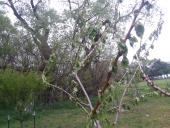Dwarf trees need trellis support for the fruit load, or there's a good chance a heavy fruit load could snap the trunk at the graft union altogether. It is an emergency repair.
Sounds like a spindle system, very common in WA.
Your new bestests friends are the cider people at WSU in Mt. Vernon. I would pay a visit, they know their stuff, even if you have to tweak it to a permaculture/organic profile. They can explain what you've got, fireblight, etc. and maybe steer you to a consultant.
There's a couple cider orchards over around Port Townsend, one in particular they are doing way beyond organic.
Alpenfire, I met the Bishops at CiderCon2014, real good eggs.
Michael Phillips, get both books. I'm signed up for a copy of the Permaculture Orchard DVD which I suspect will be of use to you too.
20 years is a full lifespan for dwarf trees, so it's not too early to think about what you will replant with. Demand for cider apples is outrunning supply nationally and projected to continue growing, that's good news. You might try for a long-term contract with a cider house, grow the varieties they want. It's a bit late to graft up for next year, so you have time to plan and scheme.
What a wonderful opportunity.






 2
2




















 1
1
















 1
1












